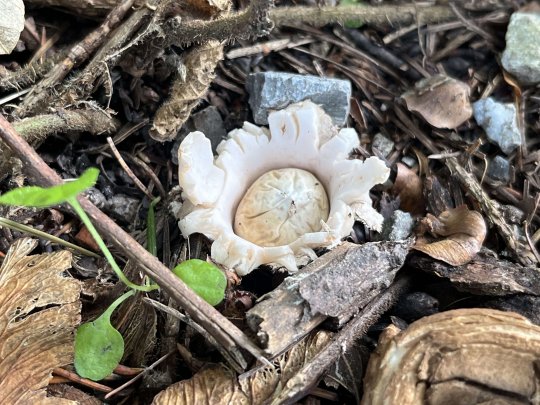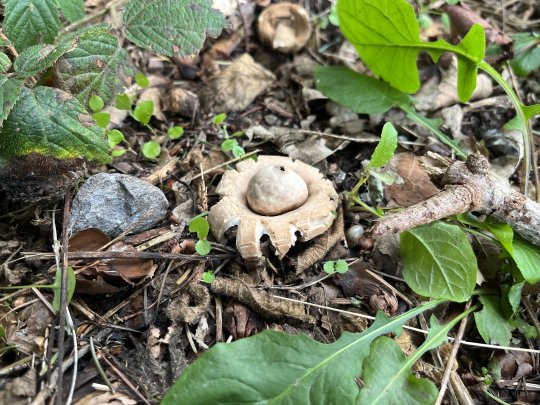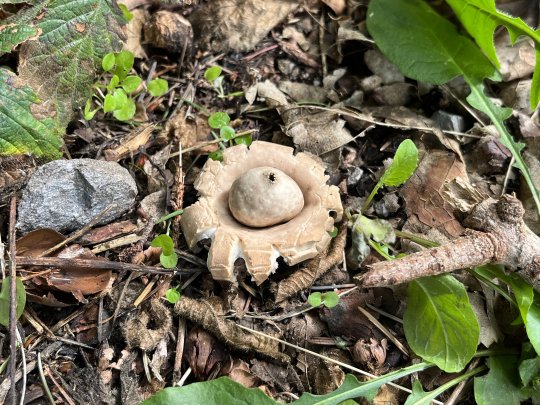Geastrum triplex
Description
Geastrum triplex is an inedible fungus found in the detritus and leaf litter of hardwood forests around the world. It is the largest member of the genus Geastrum and expanded mature specimens can reach a tip-to-tip length of up to 12 centimeters (4.7 in).
Immature fruit bodies are spherical — somewhat resembling puffballs with pointed beaks — and are partially or completely buried in the ground. As the fungus matures, the outer layer of tissue (the exoperidium) splits into four to eight-pointed segments that spread outwards and downwards, lifting and exposing the spherical inner spore sac.
The spore sac contains the gleba, a mass of spores and fertile mycelial tissue that when young is white and firm, but ages to become brown and powdery. Often, a layer of the exoperidium splits around the perimeter of the spore sac so that it appears to rest in a collar or saucer. Atop the spore sac is a small pointed beak, the peristome, which has a small hole from which spores may be released.
The species is widespread and can be found in Asia, Australasia, Europe, and both North and South America.
The fungus has a history of use in the traditional medicines of native North America and China. Fruit bodies have been analyzed chemically to determine their lipid content, and various chemical derivatives of the fungal sterol ergosterol have been identified.
Geastrum indicum is a synonym, according to some mycologists.
Common names: Collared Earthstar, Saucered Earthstar, Triple Earthstar.
Mushroom Identification
Ecology
Saprobic; growing alone or gregariously under hardwoods; summer and fall (overwinter in warmer climates); widely distributed in North America.
Fruiting Body
At first, a smooth, egg-shaped ball with a prominent pointed beak, 1-5 cm wide, attached to the substrate by a point at the base; with maturity the outer skin peeling back to form 4-8 more or less triangular, buff-colored, non-hygroscopic arms that are thick and usually develop fissures and cracks, frequently splitting to form a saucer; spore case more or less round, smooth, brownish, with a fuzzy conical beak that is often surrounded by a pale area; 5-10 cm across when arms are opened; the interior of spore case initially solid and white but soon powdery and brown.
Spore Mass
Dark brown.
Microscopic Features
Spores 3.5-4.5 µ; round; spiny; brownish to cinnamon in KOH. Capillitial threads 3-6 µ wide; yellowish in KOH; incrusted.
Look-Alikes
The rays do not always crack around the perimeter to form a bowl under the spore case. However, it is larger than either of these species. The combination of characteristics that distinguish G. triplex from other earthstars includes the lack of debris adhering to the outer surfaces, the saucer-like base in which the spore case is seated, the relatively large size, the fibrillose peristome, and the paler area surrounding the peristome separating it from the rest of the endoperidium. Unlike some other Geastrum species, the rays of G. triplex are not hygroscopic: they do not open and close in response to changes in humidity.
Uses
Edibility
Although the fruit bodies of Geastrum triplex are nonpoisonous, they are tough and fibrous, and of "no alimentary interest". Mycologist David Arora says that they are reputed to be edible when immature—when the gleba is still white and firm—but adds that they are rarely found in this form.
In traditional medicine
Earthstars were used medicinally by Native American Indians. The Blackfoot called them ka-ka-toos, meaning "fallen stars", and according to legend, they were an indication of supernatural events. The Cherokee put fruit bodies on the navels of babies after childbirth until the withered umbilical cord fell off, "both as a prophylactic and a therapeutic measure". In traditional Chinese medicine, G. triplex is used to reduce inflammation in the respiratory tract, and to staunch bleeding and reduce swelling.
Chemistry
The fruit bodies of Geastrum triplex have been chemically analyzed and shown to contain several bioactive compounds, including fungal sterols such as ergosta-4,6,8,(14),22-tetraen-3-one,5,6-dihydroergosterol, ergosterol, and peroxyergosterol. The fungus also contains various fatty acids, notably myristic, palmitic, stearic, oleic, alpha-linolenic, and linoeic acid.
History
The species was first described scientifically, by German botanist Franz Wilhelm Junghuhn, as Geaster triplex in 1840. The earlier genus name Geaster, introduced by Italian botanist Pier Antonio Micheli in 1727 in Nova Plantarum Genera, is considered an orthographical variant of Geastrum. Junghuhn, who was living in Indonesia and extensively surveyed its fungal flora, discovered the type specimen on Mount Panggerangi on the island Java, at an elevation between 3,000 to 5,000 feet (910 to 1,520 m).
The morphological feature used by Junghuhn to differentiate G. triplex from other similar earthstars was the collar-like structure of the inner layer of the exoperidium.
Several authors have regarded Geastrum indicum as the correct name for G. triplex. This is because G. indicum — a species described by Johann Friedrich Klotzsch in 1832 as Cycloderma indicum and then moved to Geastrum by Stephan Rauschert in 1959—may be the same species as Geastrum triplex. If it is the same species, the first published name (i.e., G. indicum) has nomenclatorial priority according to the rules of the International Code of Botanical Nomenclature. More recently, several authors argue that G. indicum should be rejected as a nomen dubium and G. triplex maintained as the correct name for the species.
Stellan Sunhede's 1989 monograph of European species of Geastrum follows V. J. Staněk's concept for the infrageneric (below the level of genus) placement of Geastrum, and places G. triplex with species that do not incorporate and encrust forest debris (section Basimyceliata). G. triplex is further categorized in subsection Laevistomata, which includes species with a fibrillose peristome—that is, made of parallel, thin, thread-like filaments. Within subsection Laevistomata it is in stirps Triplex, due to its delimited or irregularly torn peristome.
The specific epithet triplex means "threefold", and refers to the three-layered peridium. Geastrum triplex has acquired several vernacular names, including the collared earthstar, the saucered earthstar, and the triple earthstar.
Mechanism of Dehiscence
A study has shown that the formation of calcium oxalate crystals on the hyphae that form the endoperidial layer of the basidiocarp is responsible for the characteristic opening (dehiscence) of the outer peridial layers. Calcium oxalate is a common compound found in many fungi, including the earthstars. Curtis Gates Lloyd was the first to note the presence of these crystals on the endoperidium of Geaster calceus (now known as Geastrum minimum). The formation of calcium oxalate crystals stretches the layers of the outer walls, pushing the inner and outer layers of the peridium apart.
Bioactive Compounds
A β-glucan–protein complex extracted from Geastrum saccatum was isolated and analyzed and shown to have anti-inflammatory, antioxidant, and cytotoxic activities. It is suggested that the mechanism for the anti-inflammatory activity is due to the inhibition of the enzymes nitric oxide synthase and cyclooxygenase.
Video
Photo copyright:
All photos were taken by the Ultimate Mushroom team and can be used for your own purposes under the Attribution-ShareAlike 4.0 International license.
Shape: Earthstars




